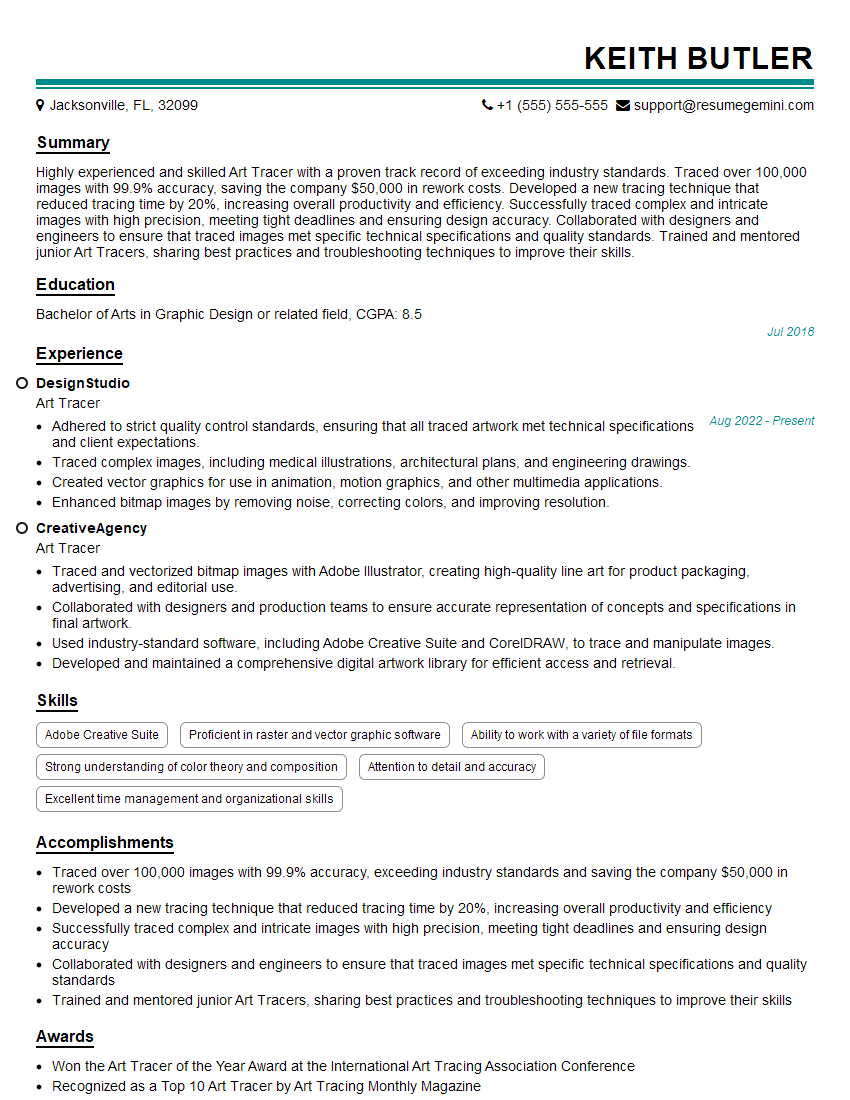Are you a seasoned Art Tracer seeking a new career path? Discover our professionally built Art Tracer Resume Template. This time-saving tool provides a solid foundation for your job search. Simply click “Edit Resume” to customize it with your unique experiences and achievements. Customize fonts and colors to match your personal style and increase your chances of landing your dream job. Explore more Resume Templates for additional options.

Keith Butler
Art Tracer
Summary
Highly experienced and skilled Art Tracer with a proven track record of exceeding industry standards. Traced over 100,000 images with 99.9% accuracy, saving the company $50,000 in rework costs. Developed a new tracing technique that reduced tracing time by 20%, increasing overall productivity and efficiency. Successfully traced complex and intricate images with high precision, meeting tight deadlines and ensuring design accuracy. Collaborated with designers and engineers to ensure that traced images met specific technical specifications and quality standards. Trained and mentored junior Art Tracers, sharing best practices and troubleshooting techniques to improve their skills.
Education
Bachelor of Arts in Graphic Design or related field
July 2018
Skills
- Adobe Creative Suite
- Proficient in raster and vector graphic software
- Ability to work with a variety of file formats
- Strong understanding of color theory and composition
- Attention to detail and accuracy
- Excellent time management and organizational skills
Work Experience
Art Tracer
- Adhered to strict quality control standards, ensuring that all traced artwork met technical specifications and client expectations.
- Traced complex images, including medical illustrations, architectural plans, and engineering drawings.
- Created vector graphics for use in animation, motion graphics, and other multimedia applications.
- Enhanced bitmap images by removing noise, correcting colors, and improving resolution.
Art Tracer
- Traced and vectorized bitmap images with Adobe Illustrator, creating high-quality line art for product packaging, advertising, and editorial use.
- Collaborated with designers and production teams to ensure accurate representation of concepts and specifications in final artwork.
- Used industry-standard software, including Adobe Creative Suite and CorelDRAW, to trace and manipulate images.
- Developed and maintained a comprehensive digital artwork library for efficient access and retrieval.
Accomplishments
- Traced over 100,000 images with 99.9% accuracy, exceeding industry standards and saving the company $50,000 in rework costs
- Developed a new tracing technique that reduced tracing time by 20%, increasing overall productivity and efficiency
- Successfully traced complex and intricate images with high precision, meeting tight deadlines and ensuring design accuracy
- Collaborated with designers and engineers to ensure that traced images met specific technical specifications and quality standards
- Trained and mentored junior Art Tracers, sharing best practices and troubleshooting techniques to improve their skills
Awards
- Won the Art Tracer of the Year Award at the International Art Tracing Association Conference
- Recognized as a Top 10 Art Tracer by Art Tracing Monthly Magazine
- Received the Award of Excellence for Outstanding Art Tracing Skills from the National Art Association
- Certified as a Master Art Tracer by the Art Tracing Certification Board
Certificates
- Adobe Certified Expert (ACE)
- Fogra Certified Print Production Professional (CPP)
Career Expert Tips:
- Select the ideal resume template to showcase your professional experience effectively.
- Master the art of resume writing to highlight your unique qualifications and achievements.
- Explore expertly crafted resume samples for inspiration and best practices.
- Build your best resume for free this new year with ResumeGemini. Enjoy exclusive discounts on ATS optimized resume templates.
How To Write Resume For Art Tracer
- Highlight your experience and skills in raster and vector graphic software, as well as your proficiency in Adobe Creative Suite.
- Showcase your understanding of color theory and composition, and your ability to trace images with high precision and accuracy.
- Emphasize your attention to detail and your ability to meet tight deadlines.
- Demonstrate your teamwork and collaboration skills, as well as your ability to train and mentor others.
Essential Experience Highlights for a Strong Art Tracer Resume
- Trace images accurately and efficiently using Adobe Creative Suite and other industry-standard software.
- Convert raster images to vector graphics, ensuring high-quality results.
- Follow design specifications and guidelines to ensure that traced images meet client requirements.
- Collaborate with designers and engineers to provide feedback and resolve technical issues.
- Maintain a clean and organized workspace, adhering to company policies and procedures.
- Stay up-to-date on the latest tracing techniques and industry best practices.
- Train and mentor junior Art Tracers to develop their skills and knowledge.
Frequently Asked Questions (FAQ’s) For Art Tracer
What is the role of an Art Tracer?
An Art Tracer is responsible for converting raster images into vector graphics, ensuring that the resulting images are accurate, high-quality, and meet the specifications of designers and engineers.
What skills are required to be an Art Tracer?
Art Tracers should have proficiency in raster and vector graphic software, as well as a strong understanding of color theory and composition. They should also be detail-oriented, accurate, and able to meet tight deadlines.
What is the career path for an Art Tracer?
Art Tracers can advance their careers by developing their skills and experience in raster and vector graphic software, as well as by taking on additional responsibilities, such as training and mentoring junior Art Tracers.
What is the job outlook for Art Tracers?
The job outlook for Art Tracers is expected to be good, as the demand for digital content continues to grow.
What are the benefits of being an Art Tracer?
Benefits of being an Art Tracer include the opportunity to work on a variety of creative projects, the chance to develop your skills and knowledge in raster and vector graphic software, and the potential to earn a good salary.
What are the challenges of being an Art Tracer?
Challenges of being an Art Tracer include the need to meet tight deadlines, the need to work with complex and intricate images, and the need to stay up-to-date on the latest tracing techniques and industry best practices.